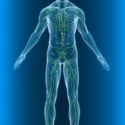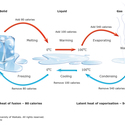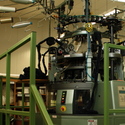Position: Associate Professor Senior Lecturer, Victoria University of Wellington and MacDiarmid Institute for Advanced Materials and Nanotechnology1.
Field: Physics.
Physics at work and play
Dr Ben Ruck is someone who makes the most of his passion for physics. He works with physics and plays with physics. For work, Ben teaches physics to students at Victoria University of Wellington, and he also heads a research team working on new materials for the MacDiarmid Institute for Advanced Materials and Nanotechnology. Outside work, when he’s not with his family, Ben does kickboxing and mountain running. Both are sports where knowledge of forces and motion give him an edge.
New materials
Ben’s work is with thin films, just a few nanometres thick, of rare-earth nitrides, such as gadolinium2 nitride3. The rare-earths are a closely related group of metallic elements4, which you’ll normally find shown at the bottom of the periodic table5. When combined with nitrogen6, some of these rare-earths become new semiconductor7 materials, with interesting magnetic and electrical properties. This is the world of spintronics. Electronic devices work by controlling the flow of electric charges8 (that is, electrons). It has recently been discovered that it is also possible to control the electrons’ magnetic properties, called ‘spin’ – hence spintronics.
Theory meets experiment
Theoretical chemists use their knowledge of such things as atomic structure9 and the periodic table to predict the properties of chemical compounds and what might happen in chemical reactions. A few years ago, Ben, who is an experimental physicist, realised that theoretical chemists were trying to predict the properties of rare-earth nitrides, but they had very little experimental data10 to guide them. Ben had already developed ways to grow a semiconductor called gallium nitride, so he was able to turn his skills to helping the theorists test their ideas.
While the theorists needed the data from Ben’s practical experiments, Ben needed to expand his knowledge of theory11 to understand his results. He had to find out about the theory of the electric and magnetic structure of atoms. He also had to learn new experimental techniques, such as X-ray spectroscopy12, and how to grow nanofilms of material in a vacuum13 to keep them pure.
Of course, Ben doesn’t work alone. He works closely with scientists around New Zealand and with others in Australia, America and France.
Like all scientists, Ben is always feeding his curiosity. He has been drawn to science because he sees it as a challenge, a way of getting to the bottom of mysteries. He is attracted to the idea of making things never made before, of finding out things never known before.
Useful links
In this video Dr Ben Ruck explains the role of novel14 magnetic materials in developing new ways of controlling the electronics15 inside your computer.
Home page of the School of Chemical and Physical Science16 at Victoria University of Wellington.
Find out about the project that Ben is working on with rare-earth nitrides to find a way to reduce the temperature at which data centres – giant computers – operate.
This article is based on information current in 2008 and 2018.
- nanotechnology: Understanding and working with matter at the scale of atoms and molecules. 1 nanometre is a millionth of a millimetre.
- gadolinium: A rare-earth metal (also called a lanthanide) – symbol Gd, atomic number 64.
- nitride: A class of chemical compound where nitrogen is bonded to metal or some non-metal elements. Some of the hard, tough advanced ceramics used as bearings are nitrides, for example, silicon nitride (Si3N4).
- element: A substance made of atoms that all have the same atomic number. Elements cannot be split into simpler substances using normal chemical methods.
- periodic table: The organisation of all known elements into groups with similar properties.
- nitrogen: A non-metal – symbol N, atomic number 7. Nitrogen is essential for life. It is a component of many molecules that make up cells, including DNA and proteins.
- semiconductor: A substance that can be made to conduct or block electricity. Silicon is a semiconductor that forms the basis of computer chips and many electronics components.
- electric charge: An excess of electrons on an object gives it a negative charge whereas a deficiency of electrons gives it a positive charge. Protons carry a positive charge and electrons carry a negative charge. Ions carry a positive or negative charge.
- atomic structure: The way in which atoms are arranged in a molecule
- data: The unprocessed information we analyse to gain knowledge.
- theory: To scientists, a theory provides a coherent explanation that holds true for a large number of facts and observations about the natural world. It has to be internally consistent, based upon evidence, tested against a wide range of phenomena and demonstrate problem solving.
- X-ray spectroscopy: The use of X-rays to find out the structure and properties of chemicals.
- vacuum: An absence of matter. In practice, a space that contains a very low density of matter (very low pressure) is often referred to as a vacuum.
- novel: New or unusual in an interesting way.
- electronics: 1. The study of the behaviour and control of electrons. This field has expanded enormously with the discovery of semiconductors. 2. The generic term for hardware used to build electrical components.
- physical sciences: The sciences that explore the study of inanimate natural objects, including physics, chemistry, astronomy and related subjects.









